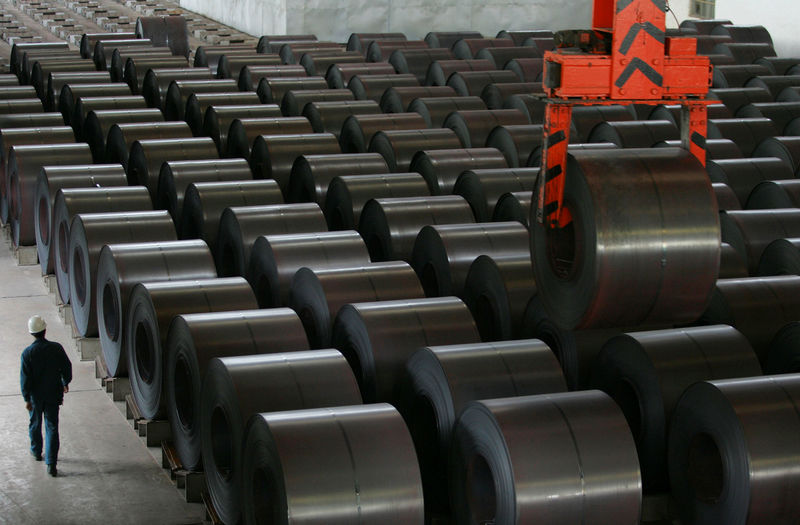By Stella Qiu and Kevin Yao
BEIJING (Reuters) - China's economy flashed more warning signs in May as the United States ramped up trade pressure, with industrial output growth unexpectedly slowing to a more than 17-year low and investment cooling, underlining a need for more stimulus.
Hours after the surprisingly weak data, China's central bank announced 300 billion yuan (£34.29 billion) in fresh support for smaller banks, though analysts expect more sweeping measures in coming months if the U.S.-Sino trade dispute intensifies.
Despite a slew of support steps since last year, China's economy is still struggling to get back on firmer footing, and investors fear a longer and costlier trade war between the world's two largest economies could trigger a global recession.
Industrial output grew 5.0 percent in May from a year earlier, data from the National Bureau of Statistics showed on Friday, missing analysts' expectations of 5.5% and well below April's 5.4%.
The reading was the weakest since early 2002, and exports were a major drag, showing only marginal growth.
Fixed-asset investment also grew less than expected, reinforcing expectations that Beijing needs to roll out more growth measures soon.
"The weakness in May’s and April’s activity data suggests that economic growth is likely to slow this quarter and increases the likelihood of additional monetary easing in the coming months," Capital Economics said in a note.
Vice Premier Liu He stoked expectations of more action on Thursday , urging regulators to do more to boost the economy and saying Beijing has plenty of tools it can use.
Analysts at Goldman Sachs (NYSE:GS) said in a note they expect authorities to further cut banks' reserve requirement ratios (RRRs) to free up more funds to lend and lower interbank interest rates. But they do not expect China to actively use currency depreciation to support the economy.
Real estate investment, a key economic driver, also showed signs of fatigue, with construction starts slowing markedly and property sales falling the most since October 2017.
"The slowdown in the real estate sector is concerning. We really need to keep an eye on its negative impact on growth," economists at ANZ said in a note to clients, trimming its 2019 growth forecast for China to 6.2% and 6% for 2020.
ANZ expects the Peoples' Bank of China (PBOC) to cut RRR by another 100 basis points (bps) this year, and lower the 7-day reverse repo rate by 5 bps in the third quarter.
The PBOC has already slashed RRR six times since early 2018 in a bid to turnaround soft credit growth. It has also injected large amounts of liquidity into the financial system and guided short-term interest rates lower.
However, despite the worsening trade outlook, China watchers appear divided over whether the central bank will cut benchmark interest rates, as it repeatedly did in past downturns.
Analysts believe policymakers are concerned more aggressive easing could fuel debt risks and put more pressure on the yuan, which is weakening towards the psychologically important 7-per-dollar level, last seen in the global crisis.
Beijing has relied more on fiscal stimulus to weather the latest downturn, including hundreds of billions of dollars in infrastructure spending and tax cuts for companies.
But Friday's data suggested domestic demand remains sluggish, adding to weaker-than-expected import and bank lending data over the last week and gloomy May factory surveys. Power generation last month grew just 0.2%.
Analysts say China is readying itself for a prolonged trade dispute, after both sides raised tariffs on each other's goods last month and U.S. President Donald Trump threatened more.
But global policymakers remain cautious ahead of a meeting between Trump and Chinese counterpart Xi Jinping at a G20 summit later this month.
"Our baseline forecast assumes that U.S.-China relations will not improve much in the foreseeable future," Oxford Economics said.
GRAPHIC - China's economic trends: http://tmsnrt.rs/2iO9Q6a
INVESTMENT DISAPPOINTS
Fixed-asset investment growth decelerated to 5.6% in January-May from the same period a year earlier. Analysts had expected it to remain unchanged from 6.1 percent in the first four months of the year.
Private sector fixed-asset investment, which accounts for about 60 percent of total investment, also lost momentum. It rose 5.3%, down from 5.5%.
The PBOC has repeatedly urged state-controlled banks to keep lending to cash-strapped smaller, private firms at lower rates, even if they are facing short-term financial difficulty, but average rates edged back up in the first quarter.
The state takeover of troubled regional lender Baoshang Bank in May has added to concerns about liquidity and financial risks, ANZ said. While the PBOC said it was an isolated case, the move jarred China's credit markets amid worries that the lending push will lead to more bad loans.
The central bank said late on Friday that it will raise the re-discount quota by 200 billion yuan (£22.86 billion) and the standing lending facility quota by 100 billion yuan for small and medium-sized banks.
ROADS AND RAIL
Infrastructure investment grew 4.0% in the first five months on-year, moderating from 4.4%.
While construction has picked up as Beijing ramps up spending on road, rail and port projects, some analysts have been puzzled by the slower-than-expected response. On Monday, China announced steps to give local governments more financing flexibility so they can increase infrastructure spending.
Property investment rose 9.5% in May, according to Reuters calculations, the slowest pace so far this year.
Retail sales bucked the downbeat trend, rising 8.6% in May on-year and picking up from 7.2% in April, a 16-year low.
Analysts surveyed by Reuters had expected a rebound to 8.1%, but some said it was likely due to higher inflation rather than a turnaround in weak consumer confidence.
Earlier this week, China's auto association reported the worst-ever monthly drop in sales.
On a positive note, nationwide unemployment readings were steady from April at 5 percent, though analysts believe the actual jobless rate is likely much higher.
